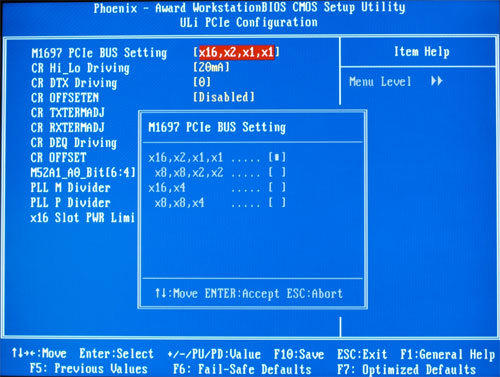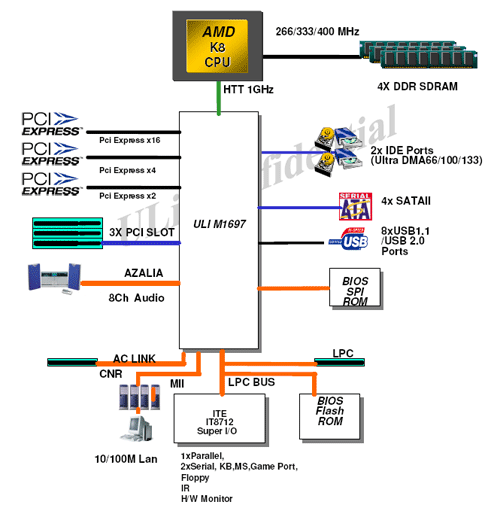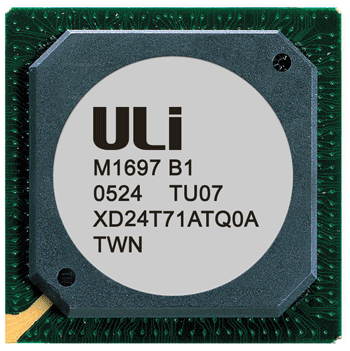FIRST LOOK: ULi M1697 for Athlon 64/x2
by Wesley Fink on December 13, 2005 12:05 AM EST- Posted in
- CPUs
ULi M1697 Chipset
The ULi M1697 chipset can support Socket 754, 939, or 940. 1000 HT (5X) is fully supported.
In addition to the configurable PCI Express graphics slots, the remaining 4 lanes are also configurable. Several settings can be selected - 2 x1/1 x2, 2 x2 or one x4 PCIe slot(s).
The rest of the M1697 feature set is what you would expect in a competitive chipset. This includes 8 USB 2.0 ports, two (4 devices) IDE Ultra DMA 66/100/133, and Super I/O supporting Parallel, Serial, PS2, and floppy ports. ULi supports all the current USB transfer standards such as HS (480Mb/s, FS (12Mb/s) and LS (1.5Mb/s). Those who have watched Digital Camera makers play games with USB 2.0 transfer rates will recognize the terms HS or High Speed and FS or Full Speed. What they may not be aware of is the 40-times speed increase of High-Speed USB 2.0 over the inappropriately named Full Speed USB 2.0 standard.
The one disappointment in the feature list is the supported Ethernet. The M1697 has the hooks to support a 10/100 Ethernet PHY, but Gigabit Ethernet will require a discrete Gigabit LAN controller, preferably on the PCIe bus. This one feature tends to pigeon-hole this otherwise excellent chipset as a value solution. That is really unfortunate, since you will see the ULi M1697 is otherwise completely competitive with the best chipsets available for AMD Athlon 64.
The ULi M1697 chipset can support Socket 754, 939, or 940. 1000 HT (5X) is fully supported.

In addition to the configurable PCI Express graphics slots, the remaining 4 lanes are also configurable. Several settings can be selected - 2 x1/1 x2, 2 x2 or one x4 PCIe slot(s).

The rest of the M1697 feature set is what you would expect in a competitive chipset. This includes 8 USB 2.0 ports, two (4 devices) IDE Ultra DMA 66/100/133, and Super I/O supporting Parallel, Serial, PS2, and floppy ports. ULi supports all the current USB transfer standards such as HS (480Mb/s, FS (12Mb/s) and LS (1.5Mb/s). Those who have watched Digital Camera makers play games with USB 2.0 transfer rates will recognize the terms HS or High Speed and FS or Full Speed. What they may not be aware of is the 40-times speed increase of High-Speed USB 2.0 over the inappropriately named Full Speed USB 2.0 standard.
The one disappointment in the feature list is the supported Ethernet. The M1697 has the hooks to support a 10/100 Ethernet PHY, but Gigabit Ethernet will require a discrete Gigabit LAN controller, preferably on the PCIe bus. This one feature tends to pigeon-hole this otherwise excellent chipset as a value solution. That is really unfortunate, since you will see the ULi M1697 is otherwise completely competitive with the best chipsets available for AMD Athlon 64.











51 Comments
View All Comments
semiconductorslave - Wednesday, December 14, 2005 - link
I was replying to the first comment on the post, "Why do all the new motherboards have all these PCIe slots when there is nothing available to stick in them."I made the assumption that since this person said there was nothing availible, that he or she did not make any effort to search. My example of Newegg and Google was narrow on purpose, showing how easy it is to find out what is availible when one starts looking. I was only trying to make a point that people instead of asking right away, could spend a little effort and maybe say something like, "I found these cards, are there any more?"
But saying, "YOU don't have the ability to see how the information's presentation is relevant." is quite an assumption on your part about my abilities.
mindless1 - Thursday, December 15, 2005 - link
Not an assumption at all, it comes straight from what you wrote, and yes it was in the context of what you'd replied to.semiconductorslave - Thursday, December 15, 2005 - link
You say, "you need to learn to think for someone other than yourself" but I didn't see you list any cards, where I at least did search and made a comment about how one should at least attempt to look for themselves before making comments like there aren't any PCI ex cards. Are you daft? You must just be trying to get my goat. I was trying to make a point but if you want to go on the attack, that isn't a productive debate anymore. I would suggest you don't take your own advice and try to think for anyone else since I don't think you can spare the mental energy.You can now have the final word as this is going nowhere.
Ozz1113 - Tuesday, December 13, 2005 - link
SCSI, raid drive controllers...Wesley Fink - Tuesday, December 13, 2005 - link
Gigabit Ethernet PCIe x1 controllers.Missing Ghost - Tuesday, December 13, 2005 - link
tv tunersceefka - Tuesday, December 13, 2005 - link
PCI-e Firewire 400 and 800 cards by SIIG and BelkinCalin - Tuesday, December 13, 2005 - link
The new Creative xFi cards are PCIe 1xLoneWolf15 - Tuesday, December 13, 2005 - link
Sad to say, they are not, they're plain-jane PCI. People had hoped they would be, but Creative is unlikely to do PCIe until its next-gen card after the X-Fi. Even with the X-Fi and todays most advanced games that can use its features, there isn't enough data being transferred to saturate the PCI bus.
mindless1 - Tuesday, December 13, 2005 - link
... isn't enough data to saturate from this one lone card, but seldom does a board only have one PCI slot. It's not the audio card that's the issue, it's when the audio card interferes with OTHER cards.